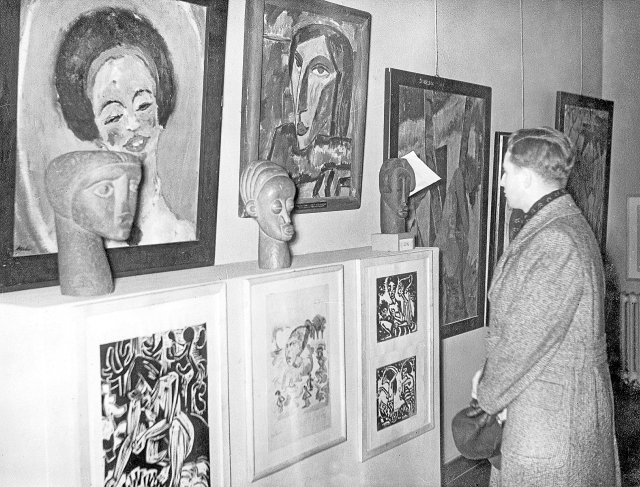On February 27, 1938, the exhibition “Degenerate Art” opened in the Haus der Kunst on Königsplatz in Berlin. This traveling exhibition started on July 19, 1937 in Munich and showed around 650 confiscated works of art from 32 German museums.
Foto: SZ Photo/Scherl
Museums convey the doctrine of the state, which pays or tolerates the museums. However, there is often disagreement among vicarious agents as to how this doctrine should be interpreted. Anita Beloubek-Hammer provides a particularly amusing example in her lavish catalog of the purges in the Berlin Kupferstichkabinett in 1937.
One of the sharpest purgers was Klaus Graf von Baudissin, once a supporter of modern art, who suddenly changed his mind in 1933 and then fervently pursued this art into its “hiding corners,” but after the war lamented that he was now “removed from office and ostracized.” « (his pension was nevertheless paid to him). The case shows once again that the Nazis were often not “political criminals,” but simply opportunists.
After the count and his commission raided the National Gallery and the Print Cabinet and confiscated hundreds of works as “degenerate,” he called a meeting of museum directors at the Pergamon Museum. One of his subordinates, Walter Hansen, explained that the approach was still too lax. Because wasn’t Vincent van Gogh also a degenerate? And Matthias Grünewald? At this point the assembled directors, all loyal to the state, must have flinched. Then Hansen delivered his heaviest blow: “We also reject Rembrandt in his ghetto art.”
Then seven museum directors jumped up and left the hall in protest. When Count Baudissin learned of this disobedience, he shouted that these directors should all be “loaded onto a plane and sent to Madrid to the Bolsheviks.” This was followed by Gestapo searches of the protestors’ houses, including the director of the Kupferstichkabinett, Friedrich Winkler, who asserted in a letter to the Reich Chancellery that he was not a member of the party, but that he had always faithfully served the National Socialist cause and, above all, was ” “Attempts at decomposition” by the Jews were fended off. After the war, Winkler remained in office and received the Federal Cross of Merit First Class in 1953.
One of Winkler’s favorite victims was his curator of contemporary art, Willy Kurth, who made a career in the GDR after the war. Winkler denounced Kurth wherever he could, even to the count he hated himself. In fact, Kurth was stripped of all decision-making powers in 1934, but through clever cooperation with director Eberhard Hanfstaengl of the Nationalgalerie, he managed to acquire works from the “Brücke” until 1937. He managed to turn down Hermann Göring, who wanted juicy art from him – “Naked Women!” – for his seat in “Carinhall” in 1934. Winkler got out of the affair by loaning originals by Cranach and Dürer to the future Reich Marshal.
Kurth is the focus of Beloubek-Hammer’s book because, in a “heroic act” in 1937, he saved hundreds of sheets of modern art from the Baudissin Commission’s grasp. This was successful, among other things, because the commission had selected 600 sheets and folders for confiscation, but had not noted down exactly what they were. Kurth was able to exchange the selected pieces for doubles and second-rate items before delivery. The commission’s negligence can probably be explained by the fact that, as early as 1937, graphics were worth far less than oil ham. And the Nazis wanted to “use” what they captured. One of their exploiters was the art dealer Ferdinand Möller. The foundation named after him has now financed Beloubek-Hammer’s richly documented catalogue. Although its frequent repetitions are annoying, it helps to better understand the history of the “Degenerate Art” campaign.
Anita Beloubek-Hammer: The “Degenerate Art” campaign in 1937 in the Berlin Kupferstichkabinett. Curator Willy Kurth saves modern master works. Biography and documentation. Lukas-Verlag, 409 pages, hardcover, €40.
Become a member of the nd.Genossenschaft!

Since January 1, 2022, the »nd« will be published as an independent left-wing newspaper owned by the staff and readers. Be there and support media diversity and visible left-wing positions as a cooperative member. Fill out the membership form now.
More information on www.dasnd.de/genossenschaft
